Transport Canada Proposes New Fatigue Rules

This September Transport Canada has finally tabled a proposal to change existing fatigue rules for flight crew. These new rules are meant to be more inline with the science of fatigue and follow the lead of other countries. Other countries that have already made changes to their fatigue rules include Australia, the United Sates, India, UAE, UK, and the EU…
Basically these new rules as proposed will limit the duty of crew members not simply with a stagnant numbers, but take into consideration the time of report for duty in a crew member’s home time zone, and the number of legs the crew member will operate. As you would presume, when a crew member reports for duty in the early morning hours, or late afternoon or night their maximum duty time will be limited compared with a report in the mid-morning.
The proposal issued by Transport Canada allows for comments and suggestions from Canadians as final drafts are be written up. It may be some time before we see these new rules becoming part of the Canadian Aviation Regulation, and, as part of the proposal, there will be a transition period for parts of the industry that may need more time. It is interesting to note that 705 and 704 operations will have less time to comply with these new rules, while 703 and 702 operators will be given 24 months once they the rules are enacted. An explanation is that 705 and 704 will not be seeing changes that are as significant as those for the 703 and 702 operators.
Some significant changes are:
- maximum duty time will never exceed 13 hours, verse the current 14 hours
- weekly flight hour limits will be removed
- weekly and monthly duty limits will be introduced
- monthly flight hour limit will be hard stopped at 112
- annual flight hours will be reduced from 1200 to 1000
- split duties are much more flexible
- unforeseen circumstances become more details
- time free from duties have been revised and better explained
- additional rest has be provided for schedules that are disruptive (big changes in report times)
- additional rest times have been added for pilots traveling over time zones
- additional rest times for pilots flying at night during low human performance times
Below I have summarized some more significant changes. Please remember that this is not complete and only a summary. To see the entire proposal visit this site: http://wwwapps.tc.gc.ca/Saf-Sec-Sur/2/NPA-APM/npaapmr.aspx?id=2893&lang=eng
Fatigue Facts
- There is a two fold chance of an accident or incident after a 10 hour shift compared with an 8 hour shift, and that increases to three fold after 16 hours.
- Human performance is degraded between 2am and 6am.
- Adding workload, such as sectors, has a measurable effect on fatigue. Increasing a one sector day to four is comparable to an additional of 2.77 hours of duty.
- Working 12 hour shifts increases the hazard rate by 37%, working 60 hour weeks increase the hazard rare by 23%.
- Being in bed for eight hours dose not mean you get eight hours of sleep. Studies indicate that an average person needs 12 hours free from duties to complete the tasks of life and still get eight hours sleep.
- 705 & 704 required time from duty tend to meet the science of fatigue, but 703 & 702 do not.
- Risk is increased for successive night shifts, with a 6% higher risk factor on the second night compared with the first, 17% higher on the third night, 36% higher on the fourth night.
Nutrition
- when a flight duty period exceeds 6 hours, the air operator shall provide the flight crew member with food and drink opportunity every 6 hours
Flight Duty Period (FDP)
- flight duty time is restricted based on time of report and planned number of sectors
- when a flight crew member is not acclimatized to time zone they will use their last acclimatized time zone when considering report time (Newfoundland is considered part of Atlantic time zone)
- when in a time zone 4 or less hours different from the last acclimatized time zone a crew member becomes acclimatized with 72 consecutive hours of rest in the same time zone
- when in a time zone 5 or more hours different from the last acclimatized time zone a crew member become acclimatized with 96 consecutive hours of rest in the same time zone
- 702 Operators
- 13 hours of duty can be assigned if duty time does not exceed 13 hours in 24 consecutive hours, a total 9 hours of opportunity to sleep in 24 consecutive hours, 5 consecutive hours of opportunity to sleep between 20:00-06:00 local, five 24 consecutive hours free from duty in 28 days

Unforeseen Circumstances
- extending duty for unforeseen circumstances is based on whether single pilot (one hour), un-augmented flight crew (two hours), augmented flight crew with one sector (three hours), and augmented flight crew with 2 or 3 sectors (two hours)
- minimum rest periods will be extended by an amount at least equal to the extension of duty due to unforeseen circumstances
- splits can be requested from an air operator and if accepted by the PIC for un-foreseen circumstances prior to the rest beginning
Delayed Reports
- when a delayed report is assigned to a crew member, before leaving the rest facility, of less than 4 hours, maximum duty time is base on the more restrictive of the original or new report time, and duty begins at report time
- when a delayed report is assigned to a crew member, before leaving the rest facility, of 4 or more hours, maximum duty time is base on the more restrictive of the original or new report time, and duty begins 4 hours after original report
- when a delayed report is assigned to a crew member, before leaving the rest facility, of 10 or more hours and the crew member is no further disturbed, the elapsed time from the original to the new report time is considered a rest period, any further delays will be referred to delays of less than 4 or 4 or more hours
Cumulative Duty Hour Limitations
- 1928 hours in 365 days
- 190 hours in 28 days
- 60 hours in 7 days (free from duty option 1, see time free from duty)
- 70 hours in 7 days (free from duty option 2, see time free from duty) if no early, late or night duties, no duty over 12 hours, no more than 24 hours duty in any 2 consecutive days
Flight Time Limitations
- 1000 hours in 356 days
- 300 hours in 90 days
- 112 hours in 28 days
- 8 hours in 24 hour period (single pilot operation)
Positioning
- time spent positioning is considered duty
- positioning prior to operating is considered part of FDP limits
- when positioning after operating and exceeding FDP limits by 3 or less hours the rest period will be as long as the preceding duty period, and if more than 3 hours (with agreement of crew member and air operator) the rest period will be double the preceding duty period
Split Duty
- FDP limit can be increased if the air operator provides a break to a crew member in suitable accommodation
- minimum break is 60 minutes
- travel to suitable accommodation is not considered part of break
- FDP can be increased by 100% when the break is between 00:00-05:59 in the acclimatized time zone, 50% between 06:00-23:59 in the acclimatized time zone, 50% when unforeseen circumstances split
- 45 minutes of a break in suitable accommodation does not count towards increasing flight duty period
- when doing a split in an assignment from standby, standby duty period can only be extended to a maximum of 2 hours and limited to 2 sectors following a break
- Suitable accommodation means, for the purpose of standby, split duty and minimum rest, a single-occupancy bedroom that is subject to a minimal level of noise, with sufficient ventilation and the ability to regulate temperature to a comfortable sleeping temperature and light intensity or, where such a bedroom is not available, accommodation that is suitable for the site and season, is subject to a minimal level of noise and provides adequate comfort, to obtain horizontal rest, and protection from the elements.
Standby
- Standby means when a crew member is required by the operator to be available to receive an assignment for a specific duty without an intervening rest period.
- air operator will give notice of start and end time of standby, and location
- 12 hours notice when the standby period does not infringe on the window of circadian low (WOCL) between 02:00 and 05:59 in a crew member’s acclimatized time zone
- 32 hours notice when the standby period infringes on the window of circadian low (WOCL) between 02:00 and 05:59 in a crew member’s acclimatized time zone
- standby period can not be shifted more than 2 hours earlier or 4 hours later than the preceding standby period, and no more than a total of 8 hours from the original standby period in the preceding 7 consecutive days, unless a crew member has 2 days free from duty
- if the standby period shifts more than 2 hours no additional standby periods can be give to the crew unless 2 days free from duty are given
- if the standby period is shifted into the window of circadian low (WOCL) between 02:00 and 05:59 in a crew member’s acclimatized time zone, the crew member must be given 24 hour notice
- if a crew member is assigned to operate a flight outside the standby period, they must be given notification at least 24 hours prior to the assignment, notification can not be received between 22:30-07:30, and no duties can be assigned between the notification and the start of the assignment
- standby periods may not exceed 14 hours
- standby periods end and the flight duty period limits begin when an assignment is received
- 10 hours of rest must be given between each standby period
- standby duty period limits when assigned for un-augmented crew
- standby period beginning 02:00-17:59 – 18 hours
- standby period beginning 18:00-18:59 – 17 hours
- standby period beginning 19:00-20:59 – 16 hours
- standby period beginning 21:00-22:59 – 15 hours
- standby period beginning 23:00-01:59 – 14 hours
- standby duty limits when assigned for augmented crew
- 20 hours with one additional crew member in class 1 or 2 rest facility
- 22 hours with two additional crew member in class 1 or 2 rest facility
- standby duty limits can be increased by 50% of the time between 02:00-05:59 when a crew member is not disturbed by the air operator to a maximum of two hours
- when a flight assignment is received during a standby period the most restrictive of the standby duty limits or flight duty period limits will apply
- 33% of standby period counts towards cumulative duty limitations
- after an assignment during a standby period and subsequent rest a crew member may resume a standby period as long as the end time of the standby period is the same as the previous
Rest Periods
- minimum of 12 hours rest before flight duty period begins at home base
- minimum of 10 hours rest in suitable accommodations before flight duty period begins when away from home base or when suitable accommodations is provided to a crew member at home base
- if the preceding flight duty period limits are exceeded plus one hour, the rest period will be at least as long as the preceding duty period
Time Free From Duty
- option 1
- one single day free from duty every 7 days
- four single days free from duty every 28 days
- the start of a day free from duty may be delayed to a maximum of 2 hours for unforeseen circumstances, but the duration of the single day off will be extended by a minimum of 2 hours
- Single day free from duty means a time free of all duties consisting of a single day and two local night’s rest and which may include a rest period as part of the single day free from duty.
- option 2
- five consecutive days free from duty within every 20 consecutive days
- to transition between the two options a crew member must be given 5 consecutive days free from duty
Additional Rest Due to Disruptive Schedules
- does not apply when location time zone is more than 4 hours different from acclimatize time zone
- when a flight duty period transitions from late or night duty to an early duty, or vise versa
- minimum of one local night’s rest between two duty periods
- Local night’s rest means when the flight crew member‘s rest period fully encompasses the hours between 22:30 to 07:30 in the local time zone.
- Late duty means a FDP finishing in the period between 00:00 and 01:59 hours, in the flight crew member‘s acclimatized time.
- Night duty means a FDP that starts between 13:01 – 01:59 and finishes after 02:00, in the flight crew member‘s acclimatized time.
- Early Duty means a flight duty period that starts between 02:00 – 06:59, in the flight crew member‘s acclimatized time.
Additional Rest Due To Time Zone Differences
- away from home base
- time zone difference is 4 hours, rest period is 11 hours in suitable accommodations
- time zone difference is more than 4 hours, rest period is 14 hours in suitable accommodations
- return to home base
- time zone difference is 4 hours, and the crew member has been away from home base for more than 36 hours, rest period is 13 hours
- time zone difference is more 4 hours but less than 10 hours, and the crew member has been away from home base for more than 60 hours or the flight duty period has infringed on the window of circadian low (WOCL) between 02:00 and 05:59 in a crew member’s acclimatized time zone the rest period will be two local nights
- time zone difference is more 4 hours but less than 10 hours, and the crew member has been away from home base for 60 hours or less and the flight duty period has not infringed on the window of circadian low (WOCL) between 02:00 and 05:59 in a crew member’s acclimatized time zone the rest period will be one local night
- time zone difference is 10 or more hours, and the crew member has been away from home base for more than 60 hours, the rest period will be three local nights
- time zone difference is 10 or more hours, and the crew member has been away from home base for 60 or less hours, the rest period will be two local nights
- Local night’s rest means when the flight crew member‘s rest period fully encompasses the hours between 22:30 to 07:30 in the local time zone.
Consecutive Duties Infringing on the WOCL
- Window of circadian low (WOCL) means the period between 02:00 and 05:59 hours in the time zone to which the flight crew member is acclimatized.
- after 3 consecutive flight duty periods that infringe on WOCL the operator will provide the crew member with a local nights rest
- a crew member can fly 5 consecutive flight duty periods that infringe on WOCL if the flight duty period includes a split that with a minimum of 3 hours of rest in suitable accommodation, following the 4th and 5th consecutive flight duty period provide the crew member with 56 hours free from duty and any break taking within the WOCL can not increase the flight duty period limit in regards to split
- Local night’s rest means when the flight crew member‘s rest period fully encompasses the hours between 22:30 to 07:30 in the local time zone.



Hello Tom,
Good to see someone else interested in this topic.
My name is Garret Healy, and I have authored two blogs:
1) for FAR 117, here in the US.
2) for the new EASA FTL which goes into effect in 2016.
I would like to create a third blog for the proposed rules in Canada. I believe that setting a generic understanding is very helpful to the industry. Would you like to help me in such a task?
I could an interested party to help review such material.
If you review my two sites:
FAR117Understanding.wordpress.com
UnderstandingEASA2016FTL.wordpress.com
You will see my level of understanding on the subject.
Thanks,
Garret